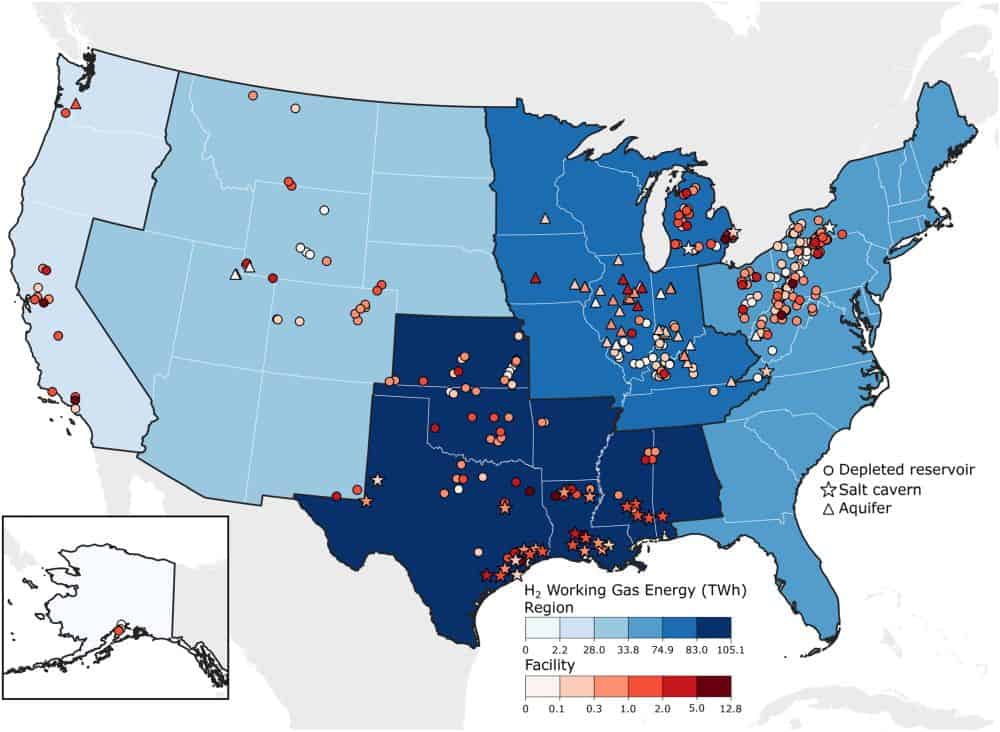
[Image above] Estimated working-gas energy (TWh) of pure hydrogen in U.S. underground gas storage facilities (light to dark red). Facility storage-formation types are designated by symbol shape. Shaded regions (light to dark blue) represent total working-gas energy (TWh) of 100% hydrogen storage by the natural gas storage reporting regions used by the U.S. Energy Information Agency. Credit: Lackey et al., Geophysical Research Letters (CC BY-NC-ND 4.0)
The use of hydrogen fuel in industrial operations has made great strides in the past year, particularly in the glass industry. These successes have spurred further investment from the U.S. government to support hydrogen adoption, such as through the National Renewable Energy Laboratory’s recently launched Roll-to-Roll (R2R) Consortium, which aims to enable high-throughput manufacturing of hydrogen technologies.
Producing and using hydrogen are only two aspects of establishing a hydrogen economy, however. We also need ways to efficiently store and transport hydrogen at scale to facilitate its widespread adoption.
The U.S. Department of Energy is funding research in this regard as well, namely through a three-year study called the Subsurface Hydrogen Assessment, Storage, and Technology Acceleration (SHASTA).
As explained in a Lawrence Livermore National Laboratory press release, naturally occurring, underground reservoirs make attractive locations for hydrogen storage thanks to their enormous volume and intrinsic layers of security. However, currently only salt dome structures or caverns are assessed for safe, large-volume underground hydrogen storage.
SHASTA was launched in 2021 to determine the viability, safety, and reliability of storing pure hydrogen or hydrogen–natural gas blends in different types of underground environments. To answer these questions, SHASTA relied on the expertise of researchers from four DOE national laboratories, with their specialties described below.
- National Energy Technology Laboratory: Expertise across subsurface capabilities designed to enable high-pressure, high-temperature reactor studies that simulate wellbore and subsurface reactions, diffusivity, wettability, and interfacial tension. Additionally, assessments on the geochemistry and microbiology of different reservoir types as well as the development of optical fiber sensors.
- Pacific Northwest National Laboratory: Expertise in geochemical interactions in batch and flowing systems, as well as in the application of high-performance reservoir simulation and geomechanical modeling capabilities.
- Lawrence Livermore National Laboratory: Expertise across the lab related to subsurface flow and transport, biogeochemistry, and technoeconomic analysis.
- Sandia National Laboratories: Expertise in applied subsurface geology, permeability testing, geomechanical rock properties testing and imaging, geochemical hydrogen-induced reaction analysis, microbiological testing, hydrogen effects on materials research, and multiphase-flow and reactive transport modeling.
Throughout the study period, the researchers published some preliminary results on specific questions being explored. For example, in February 2023, they published on an open-access article showing that existing U.S. underground gas storage facilities can viably store hydrogen–methane blends, thus reducing the need to build new hydrogen infrastructure.
In April 2024, the researchers presented the culmination of their findings during the Office of Resource Sustainability Program Review Meeting in Pittsburgh, Pa. They shared evidence for using non-salt-based subsurface environments for storage, such as porous subsurface rock found in depleted oil and natural gas reservoirs. They also described an overarching methodology for assessing hydrogen storage suitability, which they developed using two case study locations: one in Alaska’s Cook Inlet Basin and another in Pennsylvania’s Oriskany and Elk geologic formations.
Because of these successes, DOE’s Office of Fossil Energy and Carbon Management announced that it would extend SHASTA into 2025, with “the potential of further extension to address unmet needs,” as reported in the SHASTA 2024 technical workshop summary.
